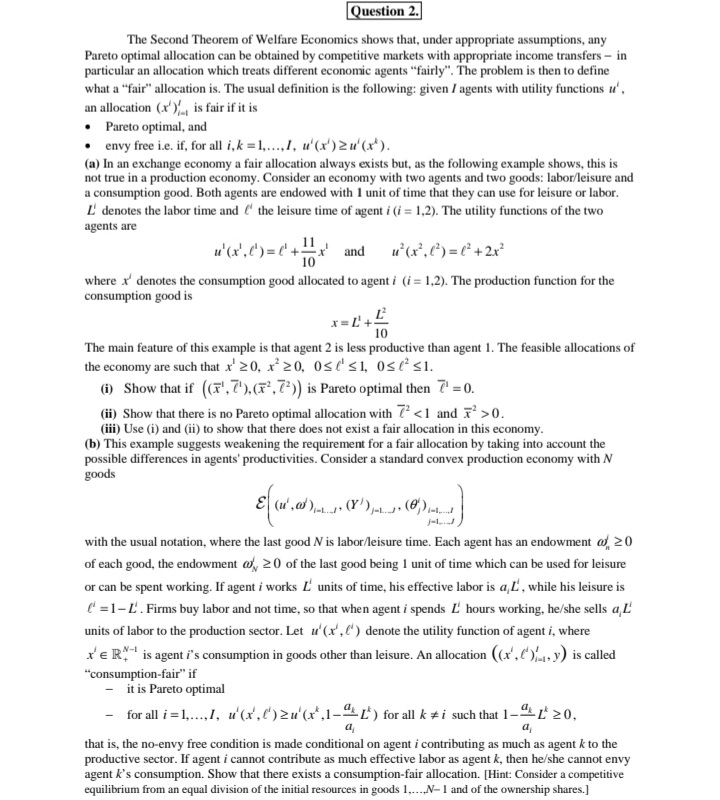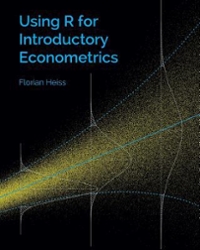give a summary
Question 3. Consider the problem of New City which is considering building a railway station and a railway line to Central City where a lot of its residents work and shop. If the city decides to build the railway it will at the same time provide services in the railway station: newspapers, food, drinks, etc. To simplify the problem let us model New City as an economy with three goods: good 1 is transportation by train, good 2 is services at the station, and the third good is a numeraire good which will be denoted by m, and which represents all other goods. The production of good 1 requires a fixed cost C of the numeraire good (for building the station and the tracks) and then one unit of m produces a, units of good 1. Good 2 is produced under constant returns, 1 unit of m produces a, units of good 2. There are / agents living in New City. Agent i has an endowment @ of the numeraire good and a quasi-linear utility function U' of the form U'(x, x,,m )=m' +u'(x)+v(x), i=1,..../ where u' and v' are twice differentiable, strictly concave, increasing functions from R, to R . The endowments @ are assumed to be sufficiently large so that the non-negativity constraint on m' will never bind for any agent in any of the scenarios considered in the exercise. We also assume that du' dv' andx - (0)21, a dry (0) 21, lim du' , lim dv 1 - dx T( x, ) =0. (a) For which values of the parameters C, a, and a, is it optimal to build the railway and provide the services? Use the notation c = -, c, =- and w a2 dx , b) To fix ideas, assume that all agents have the same preferences with u' (x, ) = aln(1 + x;), v(x;)=PIn(1+x;), for i=1,....I, a>c, B>c,, and the parameters (c.c,, C,, B) satisfy the condition found in (a) with a strict inequality. The efficient way of building the railway would be to impose lump sum taxes on the agents to finance the fixed cost and then sell good 1 and good 2 at marginal cost. Unfortunately this is not possible. Adding new taxes requires a 2/3 majority in the City Council. The City Council typically contains 40% of Reps which by principle vote against any additional tax. Another solution is to create a Railway Authority which operates the line and the railway station, selling good I and good 2 above marginal cost and using the revenue to finance the fixed cost. (i) Suppose that the price of the numeraire good is 1 and that the Railway Authority sells good I at price p, and good 2 at price p, , withc, 1.Question 2. The Second Theorem of Welfare Economics shows that, under appropriate assumptions, any Pareto optimal allocation can be obtained by competitive markets with appropriate income transfers - in particular an allocation which treats different economic agents "fairly". The problem is then to define what a "fair" allocation is. The usual definition is the following: given / agents with utility functions u', an allocation (x')_, is fair if it is Pareto optimal, and envy free i.e. if, for all i, k = 1,.... I, u'(x') zu'(x ). (a) In an exchange economy a fair allocation always exists but, as the following example shows, this is not true in a production economy. Consider an economy with two agents and two goods: labor/leisure and a consumption good. Both agents are endowed with 1 unit of time that they can use for leisure or labor. L' denotes the labor time and ( the leisure time of agent i (i = 1,2). The utility functions of the two agents are " (x' , l' ) = 0 +x 10 +x and u'(x. () = ('+2x where a denotes the consumption good allocated to agent / (i = 1,2). The production function for the consumption good is x=1+4 10 The main feature of this example is that agent 2 is less productive than agent 1. The feasible allocations of the economy are such that x 20, x 20, 0s( s1, oses1. (i) Show that if ((F', 7'), (x2, 72)) is Pareto optimal then ?' =0. (ii) Show that there is no Pareto optimal allocation with ( >0. (iii) Use (i) and (ii) to show that there does not exist a fair allocation in this economy. b) This example suggests weakening the requirement for a fair allocation by taking into account the possible differences in agents' productivity a standard convex production economy with N goods with the usual notation, where the last good / is labor/leisure time. Each agent has an endowment (, 20 of each good, the endowment @, 2 0 of the last good being 1 unit of time which can be used for leisure or can be spent working. If agent i works _ units of time, his effective labor is a, L , while his leisure is ( =1-L'. Firms buy labor and not time, so that when agent i spends 2' hours working, he/she sells a, l' units of labor to the production sector. Let #'(x', ( ) denote the utility function of agent i, where r'E R+" is agent i's consumption in goods other than leisure. An allocation ((x'. ()_, y) is called "consumption-fair" if it is Pareto optimal - for all i =1.....I, u'(x', () >u'(x*,1-"& L') for all k # i such that 1-4 1 20. that is, the no-envy free condition is made conditional on agent i contributing as much as agent & to the productive sector. If agent i cannot contribute as much effective labor as agent &, then he/she cannot envy agent &'s consumption. Show that there exists a consumption-fair allocation. [Hint: Consider a competitive equilibrium from an equal division of the initial resources in goods 1,...,N-1 and of the ownership shares.]








